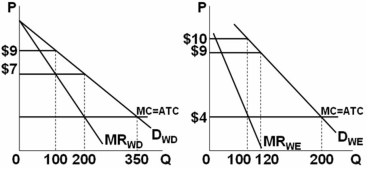Multiple Choice
 Refer to the figures above.Suppose the graphs represent the demand for use of a local golf course for which there is no significant competition (it has a local monopoly) .P denotes the price of a round of golf and Q is the quantity of rounds sold each day.If the left graph represents the demand during weekdays and the right graph the weekend demand,this profit-maximizing golf course should:
Refer to the figures above.Suppose the graphs represent the demand for use of a local golf course for which there is no significant competition (it has a local monopoly) .P denotes the price of a round of golf and Q is the quantity of rounds sold each day.If the left graph represents the demand during weekdays and the right graph the weekend demand,this profit-maximizing golf course should:
A) charge $9 for each round,regardless of the day of the week.
B) charge $7 for each round,regardless of the day of the week.
C) charge $7 for each round on weekdays,and $10 during the weekend.
D) charge $9 for each round on weekdays,and $10 during the weekend.
The monopolist should set MC = MR in both markets.That means the weekday output should be 200 per day with a price of $7 and the weekend output should be 100 per day with a price of $10.
Correct Answer:

Verified
Correct Answer:
Verified
Q11: When marginal costs decrease,a monopolist will usually
Q12: In general,the amount of X-inefficiency in an
Q13: Suppose that a monopolist calculates that at
Q14: The supply curve for the pure monopolist
Q17: Monopolists are said to be allocatively inefficient
Q18: <img src="https://d2lvgg3v3hfg70.cloudfront.net/TB4893/.jpg" alt=" Refer to the
Q20: The supply curve for a pure monopolist:<br>A)
Q21: In a monopoly,price is less than minimum
Q23: Price discrimination is<br>A) always legal.<br>B) always illegal.<br>C)
Q214: One defining characteristic of pure monopoly is